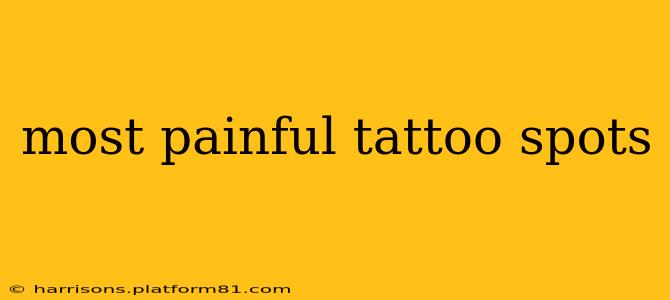The Most Painful Tattoo Spots: A Comprehensive Guide
Getting a tattoo is a deeply personal experience, a form of self-expression that leaves a lasting mark—literally. But before you dive into the vibrant world of ink, understanding the pain involved is crucial. While pain tolerance is subjective, certain areas of the body are consistently cited as more sensitive than others. This guide explores the most painful tattoo spots, explaining why they hurt more and helping you make informed decisions about your next tattoo.
Why Do Some Areas Hurt More Than Others?
The pain experienced during a tattoo is largely determined by the density of nerve endings in the skin. Areas with more nerve endings, thinner skin, and proximity to bone naturally register more pain. Other factors influencing pain perception include the individual's pain tolerance, the tattoo artist's technique, and the size and complexity of the design.
Top Painful Tattoo Spots:
-
Armpits: The skin in your armpits is extremely thin and delicate, densely packed with nerve endings. The constant movement of the arm also makes it challenging for the artist to work precisely. Add to that the sensitive nature of the lymph nodes in this area, and it becomes a prime contender for a painful tattoo experience.
-
Inner Elbows: Similar to armpits, the inner elbows possess thin skin and a high concentration of nerve endings. The bony structure beneath makes this area particularly sensitive to needle penetration. Added to this, the constant bending of your elbow can lead to irritation and potentially affect healing.
-
Knees and Ankles: Bony prominences like knees and ankles have very little muscle or fat to cushion the needle's impact. The skin is also relatively thin, which leads to increased pain levels. The movement of these joints can also cause discomfort.
-
Ribcage: The ribcage is a notoriously painful spot due to its thin skin, many nerve endings, and the proximity to bone. The constant expansion and contraction of the ribcage while breathing further exacerbates the pain.
-
Feet: The feet are another area with high nerve density, thin skin, and sensitive bone structure. The pressure from the tattoo gun can also be uncomfortable.
-
Groin: This highly sensitive area is packed with nerve endings and is very prone to discomfort during a tattoo procedure.
-
Neck: The neck, especially the areas directly under the chin or along the throat, is close to vital nerves and has relatively thin skin.
What About Less Painful Spots?
While these are some of the most painful spots, other areas are often described as less painful. These generally include places with thicker skin, more muscle and fat, and fewer nerve endings. These areas include:
- Outer Thighs and Calves: These areas generally have thicker skin and more muscle and fat to help absorb the needle's impact.
- Shoulders and Upper Arms: These areas tend to have less sensitivity than others.
- Back: A large, flat canvas with relatively thicker skin, and often less movement, the back is generally considered less painful.
How Can I Minimize Tattoo Pain?
While you can't eliminate pain entirely, you can take steps to minimize it:
-
Choose an experienced tattoo artist: A skilled artist will use techniques that minimize discomfort and ensure proper aftercare.
-
Communicate with your artist: Let your artist know if you’re experiencing more pain than expected, and they can adjust accordingly.
-
Eat a good meal beforehand: Low blood sugar can increase sensitivity to pain.
-
Stay hydrated: Hydration helps with blood flow and healing.
-
Consider numbing creams (with caution): Some topical numbing creams can help reduce pain, but always discuss this with your artist first. Misuse can lead to complications.
Remember, every individual’s experience with tattoo pain is unique. These guidelines provide general information, but ultimately your pain tolerance and the specific location on your body will dictate your personal comfort level. Choose your tattoo placement wisely, considering both the aesthetic appeal and the potential for pain.
